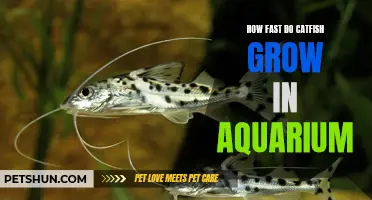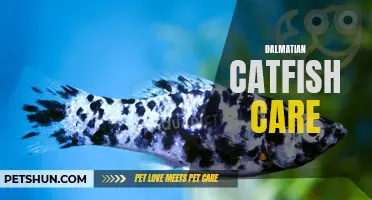
Are you a fan of catfish? Did you know that one of the most crucial aspects of raising catfish is their feeding regimen? Just like any creature, catfish need the right blend of nutrients to thrive. Whether you're a fish farmer or a catfish enthusiast, understanding the art of feeding catfish is crucial. Join us as we dive into the world of catfish feeding and explore the various methods and diets that can contribute to their growth and well-being. Get ready to discover some fin-tastic information!
| Characteristics | Values |
|---|---|
| Feeding Method | Pelleted Feed |
| Feed Size | Different sizes for different stages of growth |
| Feeding Frequency | 1-2 times a day |
| Feeding Amount | 1-2% of body weight |
| Feeding Time | Morning and evening |
| Feeding Behavior | Bottom Feeders |
| Feeding Preference | Carnivorous |
| Feeding Habits | Active hunters, prefer live prey |
| Feeding Response | Rapid and aggressive |
| Feeding Environment | Clean water and proper flow |
| Feeding Considerations | Avoid overfeeding to prevent health issues |
What You'll Learn

What is the best type of food to feed catfish?
When it comes to raising catfish, one of the most important aspects is their diet. Providing the right type of food is crucial for their growth, health, and overall well-being. In this article, we will explore the best type of food to feed catfish, taking into consideration both the scientific knowledge and practical experience.
Catfish are known to be omnivorous, which means they can eat a wide range of foods including plants, insects, crustaceans, and small fish. However, it is important to note that the nutritional needs of catfish can vary depending on their age, size, and species.
For young catfish, commonly referred to as fry, the ideal food is small in size and high in protein. This is because protein is essential for their growth and development. High-quality commercial fish feed specifically formulated for fry is readily available in the market and provides a balanced diet for them. These feeds are usually high in protein content, typically around 40-50%.
As catfish grow, their dietary requirements change. They require less protein and more carbohydrates and fats. Commercial catfish feeds designed for fingerlings and adult fish usually have a lower protein content, around 28-32%. These feeds also contain essential vitamins and minerals to support the overall health of the fish.
In addition to commercially available feeds, catfish can also be fed with natural foods found in their habitat. This includes worms, insects, small fish, and crustaceans. Many catfish farmers utilize these natural food sources to supplement the commercial feeds, as it provides a more varied diet that closely mimics their natural environment.
It is worth mentioning that the feeding habits of catfish can vary depending on the species. For example, channel catfish are known to be particularly fond of aquatic invertebrates, while blue catfish have a preference for fish-based diets. Therefore, understanding the specific dietary preferences of the catfish species you are raising can help in selecting the best type of food for them.
Feeding catfish should be done in a controlled manner to avoid overfeeding and the subsequent water pollution that can occur. It is recommended to feed catfish twice a day, providing enough food that can be consumed within 10-15 minutes. This helps to prevent excessive waste and ensures that the fish are getting the required nutrition without compromising water quality.
In conclusion, the best type of food to feed catfish depends on their age, size, and species. Commercial fish feeds specifically formulated for catfish are readily available and provide a balanced diet tailored to the nutritional needs of the fish at different stages of their life. Natural food sources such as worms, insects, and small fish can also be used to supplement the commercial feeds, providing a more varied diet. By providing the right type of food, we can ensure the optimal growth and health of our catfish.
The Ultimate Guide to Caring for Asian Stone Catfish
You may want to see also

How often should catfish be fed?
Catfish are a popular choice for many fish enthusiasts. They come in various species and are known for their hardiness and ease of care. However, one common question among catfish owners is how often they should be fed. In this article, we will discuss the feeding frequency for catfish, taking into account scientific research, experience, step-by-step guidelines, and examples.
Scientific Research:
Scientific research provides valuable insights into the feeding habits of catfish. It is important to note that different catfish species may have varying feeding requirements. However, a general guideline is to feed catfish once or twice a day. Overfeeding can lead to health issues and water quality problems, while underfeeding can result in malnutrition.
Experience:
Many catfish owners rely on their own experience to determine the feeding frequency. They observe the behavior of their catfish and adjust the feeding schedule accordingly. It is essential to pay attention to the appetite of the catfish and feed them the appropriate amount of food. Some catfish may eat more voraciously and require more frequent feedings, while others may be more selective.
Step-by-step Guidelines:
To establish a regular feeding schedule for catfish, follow these step-by-step guidelines:
A. Determine the species of catfish you own. Different species have different feeding requirements.
B. Start by feeding your catfish once a day and observe their appetite and behavior.
C. If your catfish eagerly consumes all the food within a few minutes, you can gradually increase the feeding frequency to twice a day.
D. Monitor the water quality to ensure it remains within suitable parameters. Overfeeding can lead to excess waste and poor water quality.
E. Consider the size and age of your catfish. Younger catfish may require more frequent feedings, while adult catfish can be fed less frequently.
Examples:
As an example, let's consider the popular species of catfish, the channel catfish (Ictalurus punctatus). Channel catfish can be fed once or twice a day with an appropriate portion of food. A suitable amount would be enough to be consumed within a few minutes.
Another example is the Plecostomus catfish, or commonly known as the pleco. Plecos are nocturnal feeders and primarily feed on algae. They are best fed in the evening when the tank lights are turned off. Feeding them once a day is generally sufficient, as they have a slow metabolism.
In conclusion, the feeding frequency for catfish depends on various factors, including the species, size, and age of the fish. Scientific research provides a general guideline of once or twice a day, but it is important to observe your catfish's behavior and adjust the feeding schedule accordingly. By following step-by-step guidelines and considering specific examples, catfish owners can ensure their fish receive the appropriate amount of food for optimum health and well-being.
The Complete Guide to Eclipse Catfish Care for New Fish Owners
You may want to see also

What are some common mistakes to avoid when feeding catfish?
Feeding catfish is an important aspect of their care, as their diet plays a crucial role in their health and growth. However, there are several common mistakes that catfish owners often make when it comes to feeding these fish. To ensure that your catfish are happy and healthy, it is important to avoid these mistakes.
One common mistake that catfish owners make is overfeeding their fish. It can be tempting to feed catfish more than they actually need, but this can lead to several problems. Overfeeding can result in poor water quality, which can in turn lead to health issues for the catfish. Uneaten food can also quickly decompose and create harmful bacteria in the tank. To avoid overfeeding, it is essential to feed your catfish the right amount of food, typically two to three times a day, and to remove any uneaten food after a few minutes.
Another mistake to avoid when feeding catfish is offering a poor diet. Catfish are omnivorous and require a balanced diet that includes both plant and animal-based foods. Feeding them solely with one type of food, such as pellets or flakes, can lead to nutritional deficiencies. To ensure that your catfish receive a proper diet, it is recommended to offer a variety of foods, such as worms, shrimp, algae wafers, and high-quality catfish pellets. This will provide them with the necessary nutrients they need to thrive.
It is important to note that catfish are bottom-dwelling fish and prefer feeding at the bottom of the tank. Therefore, another common mistake to avoid is feeding catfish in the middle or surface of the tank. Placing the food at the bottom of the tank will allow the catfish to easily access it and consume it at their own pace. Additionally, providing hiding spots and decorations at the bottom of the tank will create a more natural environment for the catfish and stimulate their feeding behaviors.
Finally, a mistake that catfish owners often make is not adjusting the feeding routine based on the fish's size and age. As catfish grow, their feeding requirements change. Young catfish require more frequent feedings and smaller food particles, while adult catfish need larger food and less frequent feedings. It is important to monitor the growth of your catfish and adjust their feeding routine accordingly to ensure that they receive the appropriate amount of food for their size and age.
In conclusion, when feeding catfish, it is important to avoid common mistakes such as overfeeding, offering a poor diet, feeding at the wrong location, and not adjusting the feeding routine based on the fish's size and age. By following these guidelines, you can provide your catfish with a healthy and balanced diet, ensuring their overall well-being and longevity.
The Ultimate Gulper Catfish Care Guide: Tips for Keeping and Caring for Your Gulper Catfish
You may want to see also

Can catfish be fed dried or frozen food, or should it be live?
Catfish are omnivorous creatures that will eat a wide range of foods. When it comes to feeding catfish, owners often wonder whether it is better to provide live food or if dried or frozen options are acceptable. The truth is that catfish can be fed a variety of foods, including both live and non-live options, depending on their individual needs and preferences.
Live food is often considered the most natural and nutritionally beneficial option for catfish. It allows them to exhibit natural feeding behavior and provides them with the opportunity to hunt and capture their prey, which can help keep them mentally stimulated. Live food options for catfish include feeder fish, insects, worms, and shrimp. Many catfish owners enjoy the process of raising live food themselves, as it allows them to provide their fish with a diverse and fresh diet.
However, feeding live food to catfish is not without its drawbacks. Live prey can introduce diseases and parasites into the tank, which can be harmful to the catfish. Additionally, live food can be more expensive and time-consuming to acquire and maintain compared to other options.
For these reasons, many catfish owners opt to feed their fish dried or frozen food. Dried foods such as flakes or pellets are convenient options that can be easily stored and fed on a regular schedule. These commercially available options are often nutritionally balanced and fortified with vitamins and minerals to ensure that the catfish is receiving a complete diet. It is important to choose a high-quality brand that is specifically formulated for catfish to ensure that their nutritional needs are being met.
Frozen food can also be a good option for feeding catfish. Frozen foods, such as brine shrimp, bloodworms, and daphnia, provide a similar nutritional profile to live food without the risk of introducing diseases and parasites into the tank. Frozen food can be thawed before feeding or fed directly as a frozen block, depending on the preferences of the catfish.
Ultimately, the decision of whether to feed catfish live, dried, or frozen food depends on the individual fish and the owner's preferences. Some catfish may thrive on a diet of live food, while others may do just as well on a diet of dried or frozen food. It is important to observe the catfish's behavior and health after feeding to ensure that they are receiving the proper nutrition.
In conclusion, catfish can be fed a variety of foods, including both live and non-live options. Live food provides the most natural feeding behavior and mental stimulation for catfish but carries the risk of introducing diseases and parasites. Dried and frozen foods are convenient and nutritionally balanced alternatives that can provide catfish with a complete diet. It is important to choose high-quality brands and observe the catfish's health and behavior to ensure that their nutritional needs are being met. Ultimately, the best diet for a catfish is one that is balanced, varied, and tailored to their individual needs.
The Essential Guide to Juruense Shovelnose Catfish Care
You may want to see also

Are there any supplements or additives that can enhance the growth and health of catfish when fed?
Catfish is a popular species of fish that is commonly grown in aquaculture systems. In order to enhance the growth and health of catfish, there are several supplements and additives that can be used when feeding them.
One important supplement that can enhance catfish growth is protein. Catfish require a high amount of protein in their diet in order to grow quickly and efficiently. Protein supplements can be added to the catfish feed to meet their dietary needs. These supplements can be made from a variety of sources such as fish meal, soybean meal, or poultry byproduct meal. It is important to choose a protein supplement that is high in quality and easily digestible for catfish.
Another important supplement for catfish is vitamins and minerals. These nutrients are vital for the overall health and development of catfish. Many catfish feeds are supplemented with vitamins and minerals to ensure that the fish are receiving all the nutrients they need. Some common vitamins and minerals that are important for catfish growth include vitamin C, vitamin E, and calcium.
In addition to protein and vitamins/minerals, there are also other additives that can be used to enhance the growth and health of catfish. Probiotics, for example, can be added to the catfish feed to improve digestion and nutrient absorption. Probiotics are beneficial bacteria that can help maintain a healthy gut microbiome in the fish, leading to better overall health and growth.
Another useful additive for catfish is essential fatty acids. These fatty acids are important for catfish growth, especially during the early stages of development. Essential fatty acids can be sourced from fish oil or other oil supplements. These fatty acids are important for the development of the fish's nervous system, immune system, and reproductive system.
When using supplements and additives for catfish, it is important to follow recommended guidelines and feed ratios. Over-supplementation can have negative effects on the fish and can lead to health issues. It is also important to choose high-quality supplements and additives that have been specifically formulated for catfish.
In conclusion, there are several supplements and additives that can enhance the growth and health of catfish when fed. Protein supplements, vitamins and minerals, probiotics, and essential fatty acids are all important components to consider when formulating catfish feed. By providing catfish with a balanced diet that includes these additives, aquaculturists can promote the growth and health of their fish, leading to better overall production.
The Ultimate Guide to Tandanus Catfish Care: Everything You Need to Know
You may want to see also
Frequently asked questions
Catfish should be fed once or twice a day, depending on their age and size. Younger catfish may need to be fed more frequently, while older catfish can be fed once a day. It's important not to overfeed them, as this can lead to poor water quality and health issues.
Catfish are omnivorous, meaning they eat both plant and animal matter. A balanced diet for catfish can consist of commercially available catfish pellets or flakes, as well as live or frozen foods such as brine shrimp or bloodworms. It's also beneficial to include some vegetable matter in their diet, such as blanched spinach or peas.
It's important to monitor your catfish's feeding habits and adjust accordingly. If they quickly devour all the food and are still actively searching for more, you may need to increase the amount you are feeding them. On the other hand, if there is excess food left uneaten after a few minutes, you may be overfeeding them. It's best to provide a little less food than they can consume in a few minutes and adjust as needed.







